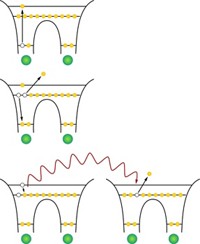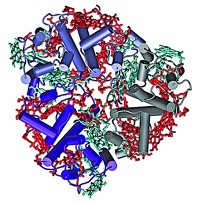Advertisement
Grab your lab coat. Let's get started
Welcome!
Welcome!
Create an account below to get 6 C&EN articles per month, receive newsletters and more - all free.
It seems this is your first time logging in online. Please enter the following information to continue.
As an ACS member you automatically get access to this site. All we need is few more details to create your reading experience.
Not you? Sign in with a different account.
Not you? Sign in with a different account.
ERROR 1
ERROR 1
ERROR 2
ERROR 2
ERROR 2
ERROR 2
ERROR 2
Password and Confirm password must match.
If you have an ACS member number, please enter it here so we can link this account to your membership. (optional)
ERROR 2
ACS values your privacy. By submitting your information, you are gaining access to C&EN and subscribing to our weekly newsletter. We use the information you provide to make your reading experience better, and we will never sell your data to third party members.
Photosynthesis
How do photosynthetic organisms handle light so efficiently?
Technical advances boost researchers’ understanding of how light-harvesting complexes operate
by Laurel Oldach
July 20, 2023
| A version of this story appeared in
Volume 101, Issue 24
It’s very easy to lose a single photon. That’s why it’s so impressive that photosynthetic systems rarely do. In contrast to photovoltaic cells, which currently top out at around 30 percent efficiency, plants and photosynthetic bacteria manage to channel roughly 95% of captured light energy into electrons.
In two recent studies, researchers at the University of California, Berkeley, and the Massachusetts Institute of Technology report on how photosynthetic bacteria can capture a single photon and funnel its energy toward a reaction center, helping us understand how the early steps of photosynthesis can be so efficient.
Photosynthetic organisms capture light using a set of proteins and pigments called the light-harvesting complex (LHC), which is embedded in cell membranes. Then, that energy transfers from one LHC to another within the membrane until it reaches a reaction center. That’s where the the redox reactions that power carbon fixation happen.
Researchers think that photosynthesizers may need just one photon to initiate each electron used for that chemistry. But most of the supporting evidence comes from bulk experiments using lasers a million times stronger than sunlight. To find out whether experimental artifacts could be affecting the conclusions, researchers in Graham R. Fleming’s and Birgitta Whaley’s labs at UC Berkeley took to a dark basement lab and fired single photons at a solution of light-harvesting proteins from photosynthetic purple sulfur bacteria.
“A single photon may sound very simple, but actually it’s pretty subtle,” says first author Quanwei Li. For starters, one can’t be completely sure about having generated a photon. The team used a quantum optics technique to generate pairs of entangled photons instead. The first photon, which the researchers called a herald, let them determine whether a second had reached the solution.
If the team detected a herald followed by a longer-wavelength photon, it indicated that the LHC had absorbed the second entangled photon and emitted its energy as fluorescence. The team’s conclusion, based on quantum correlation measurements, was that one absorbed photon was enough to stimulate one to be emitted.That is, a single photon is enough for the LHC to work with (Nature 2023, DOI: 10.1038/s41586-023-06121-5).
But in cells, LHCs need to keep light energy harnessed —which means using the photon’s energy before it can escape as fluorescence. After the LHC absorbs a photon, it’s a race to get its energy to the reaction center, says Gabriela Schlau-Cohen of MIT, a coauthor of the Nature study. When the LHC “absorbs a photon, your clock starts. You have. . . one nanosecond to either use that energy or lose it.”
Researchers know a fair amount about how energy moves within an LHC, but it has been hard to study energy transfer from one LHC to the next on its way to the reaction center. To tackle the question, Schlau-Cohen’s team embedded pairs of LHCs from bacteria into membrane-like nanodiscs (PNAS 2023, DOI: 10.1073/pnas.2220477120). They used cryo-electron microscopy to determine the orientation of and precise distance between, pigment molecules in adjacent LHCs. Then, with spectroscopy, the researchers tracked the energy transfer between them. Energy transfer took longer and was less efficient in larger nanodiscs.
Handing off captured photon energy between LHCs is like a relay race, says Gary Mo, a bioengineer at the University of Illinois Chicago who develops tools that use a similar energy-transfer principle. “Without the close approach, there’s no relay,” he says.
With a firm grip on how energy flits between LHCs, the researchers simulated a long-range transfer built from many pairwise hops. They found that it is most efficient when LHCs are disordered. Energy from light can cover a long distance by zipping between the closest-packed LHCs, finding a zigzag route to the reaction center before the clock runs out.
Plant biologist Robert Jinkerson of University of California, Riverside, calls the two studies “really cutting edge.” Though light harvesting is quite efficient, he says, much of the captured energy is lost in subsequent steps of photosynthesis. A better fundamental understanding may help researchers improve engineered approaches; after all, “the problems that biology solved are the same problems that people designing artificial photosynthesis. . . are going to have to solve,” Jinkerson says.




Join the conversation
Contact the reporter
Submit a Letter to the Editor for publication
Engage with us on Twitter